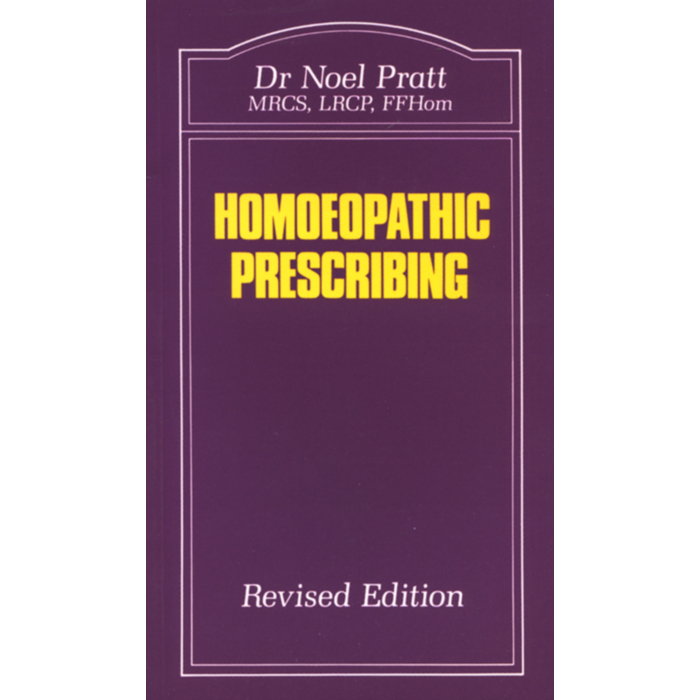Homoeopathic Prescribing
Share on social media
One hundred and sixty-one common complaints and disorders are covered in the book, arranged alphabetically for easy access. A selection of suitable remedies are then listed, together with details of the particular symptoms and signs that enable the prescriber to differentiate between each of them. The main indications for the constitutional remedies are given in the Appendix.
'Dr Pratt has written a very useful vademecum for those with a good working knowledge of homoeopathy. The way the book is set out makes for clarity and ease of access to the appropriate information.'
Homoeopathy Today
| ISBN | 9780906584033 |
|---|---|
| Author | Noel Pratt |
| Type | Paperback |
| Language | English |
| Publication Date | 1980-10 |
| Pages | 83 |
| Publisher | Beaconsfield |
| Review | This book review is reprinted from the British Homoeopathic Journal Volume 70, Number 2, April 1981, with permission from Peter Fisher, Editor. The book can be described as a modern replacement for The Prescriber by Dr J. H. Clarke, using modern terminology and English, and presenting short lists of remedies to be thought of for common ailments. It is therefore useful as a prescribing aid in the home, and for rapid reference by general practitioners, especially those who may have recently decided to use homoeopathy. It is this latter situation which particularly interests me, since in prescribing for the quick succession of patients in the surgery there is little time even for the experienced homoeopath to seek out the similimum by more formal methods. This book will, I hope, encourage the inexperienced to decide upon the "local similimum" and thereby gain experience and confidence to embark upon more complex cases. The whole concept of this book is obviously the result of much thought into the needs of possible users, the ways of meeting those needs and its final skilful presentation. One can have nothing but admiration, for an author who, resisting the wiles of publishers and accountants, insisted on the interleaving of blank pages because he knew that this would enable the book to become an educational project for the inexperienced as well as an ever enlarging source of information for future editions. Again, the slim form and soft moulding covers are much better for the pocket and the bag, than for example the most recent edition of The Prescriber by J. H. Clarke. In his introduction, Dr Pratt acknowledges his sources and it is of interest that both Clarke and Hughes are named. I agree with his view that Clark's introduction to The Prescriber is one of the best written introductions to homoeopathy at present in print. Only time will show just how useful both the concept and the actual contents are. It is up to all experienced homoeopaths to read it, use it, add to it, and then let Dr Pratt have the benefit of their own experience. In these particular circumstances the swift appearance of a second edition will be the greatest compliment to Dr Pratt and the first edition of Homoeopathic Prescribing. D. M. GEMMELL British Homoeopathic Journal |
Review
This book review is reprinted from the British Homoeopathic Journal Volume 70, Number 2, April 1981, with permission from Peter Fisher, Editor.
The book can be described as a modern replacement for The Prescriber by Dr J. H. Clarke, using modern terminology and English, and presenting short lists of remedies to be thought of for common ailments. It is therefore useful as a prescribing aid in the home, and for rapid reference by general practitioners, especially those who may have recently decided to use homoeopathy. It is this latter situation which particularly interests me, since in prescribing for the quick succession of patients in the surgery there is little time even for the experienced homoeopath to seek out the similimum by more formal methods. This book will, I hope, encourage the inexperienced to decide upon the "local similimum" and thereby gain experience and confidence to embark upon more complex cases.
The whole concept of this book is obviously the result of much thought into the needs of possible users, the ways of meeting those needs and its final skilful presentation. One can have nothing but admiration, for an author who, resisting the wiles of publishers and accountants, insisted on the interleaving of blank pages because he knew that this would enable the book to become an educational project for the inexperienced as well as an ever enlarging source of information for future editions.
Again, the slim form and soft moulding covers are much better for the pocket and the bag, than for example the most recent edition of The Prescriber by J. H. Clarke.
In his introduction, Dr Pratt acknowledges his sources and it is of interest that both Clarke and Hughes are named. I agree with his view that Clark's introduction to The Prescriber is one of the best written introductions to homoeopathy at present in print. Only time will show just how useful both the concept and the actual contents are. It is up to all experienced homoeopaths to read it, use it, add to it, and then let Dr Pratt have the benefit of their own experience.
In these particular circumstances the swift appearance of a second edition will be the greatest compliment to Dr Pratt and the first edition of Homoeopathic Prescribing.
D. M. GEMMELL
British Homoeopathic Journal
Volume 70, Number 2, April 1981


